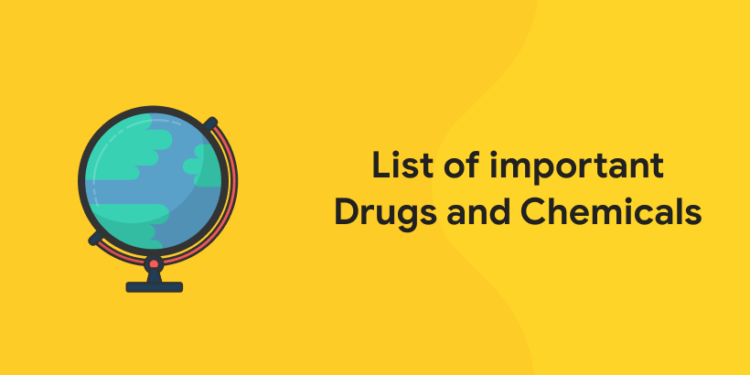Table of Contents
Some Important Drugs
Anaesthesia
Anaesthetic drugs are used at the time of the major surgical operation to stop scene organs activities. It was William Morten who used anaesthesia first time in the form of diethyl ether. Later in 1847 it was used by James Sampson in the form of chloroform. There are also so many compounds like sulphonal, veronal, chloropropane, cocaine, diagipalm, pentothal sodium, Halothane, nitrous oxide etc. which are used as anaesthesia.
Attempt Free GK Test! Download Entri App!
Antibiotics
Antibiotic drugs are developed by micro organism; moulds, fungi etc and these drugs kill another organism and check the developement (spread) of virus and bacteria. The firstly Alexander Flemming invented the drug Penicillin (antibiotic) in 1929 which is used a destroyer of virus, bacteria and fungi. Some more important antibiotics which are used often are- Tetracycline, Cephalosporin, Streptomycin, Gentamycin, Rifamycin, Chloromycitin etc.
Grab Latest Study Materials! Register Here!
Antiseptics
Antiseptic drugs are beneficial in killing micro organism (virus and bacteria) and in stopping its spread. This is particularly used to stop blood to be polluted and in cleaning wounds by appropriate antiseptics. There are three antiseptic substances which are today often used in making antiseptics as recommended by Semmelwies, Lister and Koch. Some antiseptic drugs which are usually used are Iodine, Hypochlorous acid, Ethyl alcohol, phenols Hexachlorophene, Formaldehydes, Hydrogen peroxide, Acriflavine etc.
Antipyretics
Antipyretics are used as body pain reliever and in the form of medicine of fever etc. Some important antipyretic drugs are- Asprin, Crocin, Phenacitin, Pyromidin etc.
Sulpha Drugs
These drugs are majorly collected from sulphur and nitrogen and such drugs are very effective against certain organisms. Some sulpha drugs are used particularly for animals. The first sulpha drug was sulphanilamide found and formed in 1908. Some important sulpha drugs are- Sulphanilamide, Sulphadigine, Sulpha pyridine, Sulphathiogol etc.
Attempt Free GK Test! Download Entri App!
List of Important Drugs
1, Penicillin: First on All Lists
“At the top of my list is penicillin,” Stone says. “As the first antibiotic, it pointed the way to the treatment of microbial disease. Without penicillin, 75% of the people now alive would not be alive because their parents or grandparents would have succumbed to infections. The effects of a drug like this are absolutely mind-boggling.”
No other drug changed the world like this. “If you were to ask what is the most important drug — just one — I’d say penicillin,” Greenberg says. Benet says the drug made a stark difference: “Before penicillin, if you had a serious infection, you died. “Ironically, careless use of penicillin — and many of the drugs that came after it — lets germs to develop resistance. It’s a race – and the bugs are catching up. “We are at a crossroads,” Greenberg warns. “We keep on coming up with newer and hotter antibiotics, and yet we already wore out the basic ones. So you get into the question of whether the pharmacology people will be able to keep up with the change in the bugs they are fighting. That is going to be really the cutting edge of the future.”
2. Insulin: The First Hormone Therapy
Patients with advanced diabetes can’t use the energy stored in their bodies. No matter how much they eat, they starve. Why? Their bodies stop making a hormone known as insulin, that is required to change sugar into energy.
Diabetes used to be known as “the sugar sickness.” The only cure was to give patients a near-starvation diet. They got only as much food as they could digest. They soon died. Canadian researchers Frederick Grant Banting, MD, and Charles Best, then a graduate student, first recognized insulin in 1921. In 1922, a Canadian patient got the first successful treatment with insulin taken out from an animal. Need for the new miracle treatment quickly exceeded supply, but pharmaceutical companies soon boosted up production. “Insulin can very much change the lives of diabetes patients,” Swann says. “If you look at what was available to people who suffered diabetes before insulin, those diets were just horrible. People with diabetes didn’t have too long to live. Insulin is a great example of what can be accomplished in terms of collaboration between industry and academic researchers.” Insulin proved to be a hormone. As such, it’s the grandfather of all other hormone-replacement therapies.
3. Small pox Vaccine, Polio Vaccine
Vaccines aren’t really drugs. But the experts declare that preventive medicine has to be taken into account. And few preventive medicines have had the impact of the smallpox and polio vaccines. Smallpox is by nearly universal acclaim first among the most terrible plague of humanity. Thanks to vaccination, which got its name from the Vaccinia cowpox virus used in the vaccine, smallpox is the first disease wiped from the face of the earth. (That cultures still exist in laboratories is another story).And polio is on the edge of being the second curse to be vanished. Thanks to the vaccine, it’s hard now to remember how dreadful polio once was. “Polio really made a major impact,” Benet says. “In the 1940s and 1950s, you couldn’t go swimming because parents were worried about polio. A huge number of people were affected.” Thanks to the success of these vaccines, modern vaccination succeeds in keeping many other nasty bugs at bay.
4. Ether: The Making Of Modern Surgery
Ether has paved way to more modern drugs. But its significance can’t be overstated, the experts tell WebMD. “The reason for that is it is the first drug used as an anesthetic,” Stone says. “People used to have limbs literally sawn off while they were held down. Ether made it clear that it is possible to have an agent that can depress a person’s brain functioning so major operations can be carried out. Since then there have been improved versions of anesthetics.” That binds ether’s place among the most important drugs ever.
 5. Morphin: Banning the Bane of Pain
5. Morphin: Banning the Bane of Pain
6. Aspirin: More Than A Headache Pill
“Aspirin was the first drug to exhibit that you can treat simple pain,” Stone says. “In terms of the number of people who make use of it, it is more or less determining for quality of life. Most people in the world have some kind of peripheral pain, muscle pain, or headache or arthritis, just to give a few examples. For those people, morphine would be not suitable. As an analgesic, aspirin is very important.”
Of course, there now are analgesics with same methods of action. Some work better for some people, and some avoid some of aspirin’s side effects. But more than 100 years after its invention, it’s still broadly recommended and widely used.
“I would single out aspirin from all the other [drugs of its class],” Benet says. Stone and Greenberg remark that aspirin is having an improvement. It fights inflammation, a process at the core of heart disease and, perhaps, some cancers. “It’s funny that now every man over 40 and every women over 50 is supposed to be taking this 100-year-old drug,” Greenberg says.
7. Salvarsan: The Cure For Lust
Salvarsan is the trade name for arsphenamine, invented in 1909. It’s also known as Ehrlich 606 because it was the 606th compound tested by the legendary German scientist Paul Ehrlich and colleague Sahachiro Hata as a treatment for syphilis. It did work as the arsenic-based compound is a little more poisonous to syphilis bacteria than it is to humans.The treatment made people terribly ill. But it didn’t kill them, which syphilis would finally do. Some 20 to 40 treatments, over the course of a year, were needed to cure the disease.”Salvarsan was a specific treatment for a specific disease. This was the promise that lay before the rest of the century,” Greenberg says. “You would be hard pressed to leave it off the list. “More significantly, Salvarsan was the first chemotherapy. Most modern cancer drugs work in much the same way. They are poisonous, hard-to-take drugs dosed to kill a disease before they kill the patient. With Salvarsan, Ehrlich started another modern tradition: the idea that drugmakers have moral responsibilities. “People threw rocks at his window,” Greenberg says. “They said syphilis was God’s punishment for fornicators and that Ehrlich was interfering.”
8. Psychiatric Medications: Calming The Troubled Mind
The insane asylums of ancient times were constructed to accomodate people suffering from the serious psychiatric diseases known as psychoses. These drastic diseases brought down upon patients equally drastic “treatments.”
The invention of modern psychiatric drugs in the 1950s changed everything. Benet proposed the low-potency antipsychotic drug Thorazine for the top 10 list. Stone prefers Haldol, the first high-potency antipsychotic.
“Thorazine let us not to have insane people,” Benet says. “It was the first drug for modern psychopharmacology. The only productive one before that was lithium, but Thorazine let you treat people so they were ambulatory rather than putting them into insane asylums.” “Haldol was one of the first drugs to bring schizophrenia under control,” Stone says. “It acts particularly on the parts of the brain affected in schizophrenia without just depressing the patient and being a sedative.” Greenberg agrees that psychiatric drugs belong in the top 10. “The social things about the psychiatric drugs have all sorts of modern resonance,” he notes. “These drugs led directly to today’s deinstitutionalization of schizophrenics and people with mood disorders.”The modern grandchildren of Thorazine and Haldol are the modern “atypical” antipsychotics. These drugs reduce many of the side effects that remain a significant problem for psychiatric patients.
9. Birth Control Pill
Oral contraceptives changed the world, Benet says. Other experts too agree. By giving women control over their reproductive system, these drugs had far-reaching medical and social impact.
10. Help for the Heart
Today heart patients owe a lot to two breakthrough drugs: Lanoxin (digoxin) and Lasix (furosemide, also sold as Lo-Aqua). “Digoxin makes the list, because a lot of people with heart failure would be dead without it,” Stone says. “I had digoxin originally, but I will go with furosemide [Lasix, Lo-Aqua], one of the first loop diuretics — water pills — which is still a very important drug for hypertension and heart failure,” Benet says. “Heart disease is so important, and furosemide made a major breakthrough. We have better drugs today, but that was the breakthrough in terms of really being effective. We have so many drugs for congestive heart failure now, but a lot of patients can be treated effectively with cheap diuretics.”
In terms of avoiding heart disease, the new cholesterol-lowering drugs called statins promise to have a great impact. One of the first of these drugs, Lipitor, makes Benet’s list because of its “profound impact on cholesterol lowering.” Other experts say the statins are too new — with too short a track record — to put on the same list as penicillin.
Attempt Free GK Test! Download Entri App!
More Great Drugs
- L-dopa: “When it came out it was such a wonder drug for people with Parkinson’s disease,” Stone says. “In the latter stages, these people are fully unable to move. But give them a shot of L-dopa and they are walking in 15-20 minutes. And it is important also for confirming what we knew about the mechanisms of the disease. We soon will see major advances in Parkinson’s treatment. And this is because of the initial success of L-dopa.”
- Steroids: “Hydrocortisone and other corticosteroids have an huge range of uses any time control of inflammation and the immune system is required,” Stone says. “There would be many people with a lot of issues if we didn’t have this drug.”
- Viagra: This was a controversial choice. Most experts said they couldn’t bring themselves to put Viagra or other drugs to treat sexual disfunction on the same list as lifesaving medicines. But Stone makes a persuasive case. “Most people would agree a close physical relationship is fundamental to a good quality of life. Yet there are millions of men around the world not able to have sexual activity,” he says. “It is bringing a big improvement in these men’s quality of life. It has to be on the list.”
- The Capsule: Once upon a time, a doctor’s prescription came as a powder that had to be measured out and dissolved in water or alcohol. This caused not just inconvenience but often mistakes resulting in over- or under-doses. Then Dr. Upjohn developed the gelatin capsule. “This allowed individual dosing,” Benet says. “It predates the tablet. It is the starting of individualization in the way we treat patients.”
Grab Latest Study Materials! Register Here!
- Cyclosporine: Cyclosporine is the first drug to shut down the immune system. “With the invent of cyclosporine you have an effective transplant drug,” Benet says. “That allowed transplants to live and not be rejected by the body.”
- HIV Drugs: Benet proposes the class of HIV drugs known as protease inhibitors. They aren’t the first AIDS drugs. But by combining protease inhibitors with other kinds of AIDS drugs, doctors found that they could keep HIV levels so low that patients did not get AIDS. The only reason more experts didn’t vote for HIV drugs is that they’re saving a place on the list for the still-undiscovered drug that actually cures AIDS.
- Ritalin: Greenberg votes for Ritalin as the drug that showed millions of kids with ADHD could have normal childhoods.
The main theme to pass an exam lies in systematic and planned preparation. If you are a candidate who wants to chase your dream career and focusing for a good foundation, Entri App has got it covered for you. Entri App offers a great online platform for all those willing to attend for different bank exams, government exams and other competitive exams. Our team of experts offer short and precise video classes which assists you in learning the concepts. Users get access to flash cards and quizzes and can attempt unlimited mock exams with the same pattern as that of the real exams. We also provide PDFs of previous years’ question papers with solutions.













